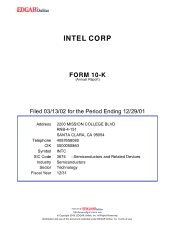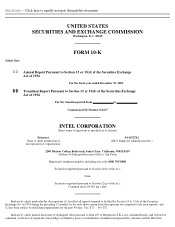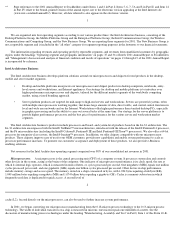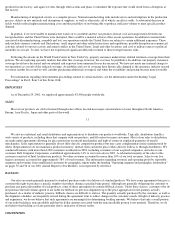Intel 2001 Annual Report Download - page 9
Download and view the complete annual report
Please find page 9 of the 2001 Intel annual report below. You can navigate through the pages in the report by either clicking on the pages listed below, or by using the keyword search tool below to find specific information within the annual report.
Wireless Communications and Computing Group
The Wireless Communications and Computing Group provides component-level hardware and software for digital cellular
communications and other applications requiring both low-power processing and high performance. Our strategy is to deliver complete
solutions that enable quick deployment of applications and services for wireless Internet and handheld computing devices. Our current products
for the handheld platform include flash memory, processors based on the Intel® StrongARM* processor and Intel XScale microarchitecture,
and cellular baseband chipsets.
In the market segment for handheld computing devices, we sell flash memory, baseband chipsets and processors to OEMs of cellular
handsets and we sell flash memory and processors to OEMs of personal digital assistants (PDAs). Growth in this market segment is dependent
on the increased use of feature-rich handsets and data-intensive applications. Growth for flash memory products will also depend on the
attractiveness of the latest features of cellular handset products, including 2.5G mobile wireless devices. These 2.5G devices are based on the
wireless technology usually associated with data transfer rates faster than 14.4 thousand individual bits of information per second (Kbps, or
kilobits per second), but slower than 384 Kbps. Our strategy is in part dependent on the willingness of current owners of handset products to
upgrade to the latest versions of these devices.
8
At the heart of our wireless product strategy is the Intel® Personal Internet Client Architecture (Intel® PCA), an open architecture
platform that describes the separation of communication and application building blocks for data-enabled cellular phones and portable
handheld devices. By separating the communication and application elements within a device, Intel PCA should allow for faster time-to-
market
for our customers and a standard, scalable platform for application development. In August 2001, we launched the Intel® Personal Internet
Client Architecture Developer Network which features more than 400 hardware and software design tools and applications, and is available to
help deliver standards-based software and hardware solutions. By the end of 2001, more than 800 companies were members of the network.
Net revenues for the Wireless Communications and Computing Group operating segment comprised approximately 8% of our
consolidated net revenues for 2001.
Flash memory. Flash memory is a specialized type of memory component used to store user data and program code; it retains this
information even when the power is off. Although flash memory is currently used predominantly in mobile phones and PDAs, it is also found
in common consumer products, including MP3 music players, handheld voice recorders and digital answering machines, as well as industrial
products.
Our Intel® StrataFlash® memory technology provides a cost-effective, single-chip solution for code execution and data storage. In
September 2001, we introduced a 3-volt synchronous Intel StrataFlash memory, which operates up to four times faster than traditional flash
memory. In October 2001, we produced the industry's first flash memory built on the 0.13-micron manufacturing process technology and plan
to beginning shipping these components to customers in the second quarter of 2002. This new flash chip is nearly 50% smaller and consumes
less power than its 0.18-micron predecessor, making it ideal for cell phones and other electronics equipment for which small form factor and
low power consumption are critical. By the end of 2001, our customers had chosen Intel StrataFlash memory for use in more than 1,200
application designs, in products such as cell phones, PDAs and set-top boxes.
Processors for handheld computing devices. Building on Intel StrongARM technology, which we license from ARM, Ltd., Intel
Xscale microarchitecture offers low-power consumption (consuming as little as 1/10,000 of a watt) and fast clock speeds and enables a new
generation of handheld and cellular devices such as those based on the Microsoft Pocket PC 2002* operating system. Future microprocessors
based on the Intel Xscale technology will be designed to scale between high performance and lower power consumption. In October 2001, we
announced that six major manufacturers of PDAs had selected the Intel StrongARM SA-1110 processor to power their next generation of
handheld communications devices. The Intel SA-1110 processor typically uses less than one half watt of power, greatly extending battery life
for handheld devices while providing powerful performance for a variety of business, multimedia and Internet applications.
In February 2002, we introduced the Intel® PXA250 and PXA210 chips, which will enable mobile phones and handheld computers to
deliver music, video and games, as well as the latest enterprise applications under development. Also in February 2002, Intel and Microsoft
announced an outline of the details of their collaboration to optimize Microsoft Windows CE.NET* for Intel PXA250 and Intel PXA210
applications processors based on the Intel XScale microarchitecture in support of the Intel PCA. The effort will enable hardware and software
developers to create powerful, connected mobile devices that utilize the latest browsing, multimedia and wireless capabilities while maximizing
battery life.
Cellular baseband chipsets. We offer baseband chipsets for designing multi-mode, multi-band wireless handsets. Based on DSP
technology, our chipsets support multiple wireless standards and deliver enhanced voice quality and high integration, while reducing power
consumption and costs. We
9






















